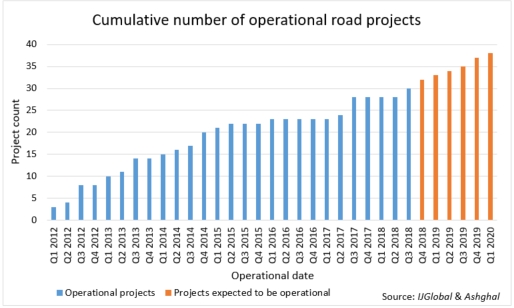Qatar’s infrastructure race to 2022 and beyond
In September (2018), Qatar’s Minister of Municipality and Environment HE Mohammed bin Abdullah al Rumaihi unveiled the Gulf state’s plans to set aside around QR20 billion ($5.49 billion) in 2019 for the ongoing revamp of Doha’s infrastructure in the run-up to the 2022 FIFA World Cup.
As shown by IJGlobal data, there has been a sustained growing trend in terms of road infrastructure and Qatar’s public works authority Ashghal has even more projects planned by the end of the decade.
Having undertaken restoration and construction of major highways outside of the capital, Qatar is now moving on with phase two of its plans. This will see major works conducted on Doha’s road network.
Ashghal is taking integrated approach, tackling major renovation of entire areas of the capital city. As demonstrated by IJGlobal data, projects are often aimed at solving multiple issues at once, such as the improvement of sewage and landscaping along the roads being constructed or overhauled – as is the case of the Greater Doha Zone 1-68 phase 2 and phase 3.
The country has added three ring roads – the E, F and G – in just four years between 2014 and 2018. Furthermore, a fourth vital road artery – the A-Ring Road – is intended to become operational in the third or fourth quarter of 2019, with a doubled capacity across its 6.7km-length.
The 2022 FIFA World Cup has set a mid-term deadline for a number of high-profile projects, including the Ras Abu Aboud Stadium and surrounding infrastructure. There are also a number of transport modernisation projects in progress, such as the Red and Green lines of Doha’s future metro and the Lusalil LRT, which should begin operations in 2020.
Qatari infrastructure remains largely funded by the government, with PPPs a rarity. What is more, as shown by IJGlobal data, infrastructure projects are more often than not awarded to local EPC contractors, or to Qatari-international joint ventures.
Attracting foreign investment would seem like a viable option but deteriorating relations with regional powers, in particular Saudi Arabia, could be prohibitive.
The government seems keen to attract more outside funding, and like other Gulf states has put forward PPP legislation to facilitate this. Any progress made on prospective PPP projects is, for now, less clear however.
Over the short-to-medium term, the burden of developing capex-heavy infrastructure looks likely to continue to rest upon the shoulders of Ashghal.
Request a Demo
Interested in IJGlobal? Request a demo to discuss a trial with a member of our team. Talk to the team to explore the value of our asset and transaction databases, our market-leading news, league tables and much more.




